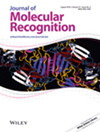
JOURNAL OF MOLECULAR RECOGNITION
分子識別雜志
- 期刊周期:Bimonthly
- 研究方向:生物
- 影響因子:1.919
- 通訊地址:JOHN WILEY & SONS LTD, THE ATRIUM, SOUTHERN GATE, CHICHESTER, ENGLAND, W SUSSEX, PO19 8SQ
- 官網(wǎng):http://onlinelibrary.wiley.com/journal/10.1002/(ISSN)1099-1352
- 投稿地址:http://mc.manuscriptcentral.com/jomr
- 審稿速度:較慢,6-12周
中文簡介
分子識別雜志(JMR)出版了原始的研究論文和評論,描述了我們在理解生命科學(xué)中的分子識別現(xiàn)象方面的重大進展,涵蓋了生物化學(xué)、分子生物學(xué)、醫(yī)學(xué)和生物物理學(xué)的所有方面。研究可采用實驗、理論和/或計算方法。該雜志的重點是涉及生物分子及其生物/生化伙伴的識別現(xiàn)象,而不是對金屬離子或無機化合物的識別。分子識別包括兩個或多個生物分子、分子集合體、細(xì)胞模塊或細(xì)胞器之間的非共價特異性相互作用,如受體配體、抗原抗體、核酸蛋白、糖凝集素等。該雜志邀請的手稿,旨在實現(xiàn)一個完整的描述分子識別機制之間的結(jié)構(gòu),動力學(xué)和生物活性方面的特征良好的生物分子。這些研究可能有助于未來新藥和疫苗的開發(fā),盡管對新藥和疫苗的實驗測試不在該雜志的范圍之內(nèi)。描述設(shè)計或建模新分子實體或描述生物分子間相互作用的標(biāo)準(zhǔn)方法和技術(shù)的應(yīng)用的手稿,但不提供對分子識別過程的新見解,將不予考慮。同樣,涉及未在序列水平上進行特征描述的生物分子的手稿(例如小牛胸腺DNA)將不予考慮。典型的技術(shù)包括拓?fù)淠M的合成、位點定向突變或分子印跡,以及定量測量分子相互作用的生物物理方法。AFM、光學(xué)鑷子、SPR、生物傳感器和微熱量測量等特定方法,以及NMR、MRI、MS、GC、LC、HPLC、PET和結(jié)晶學(xué)等一系列分析方法,可以用來建立分子識別過程的機理、動力學(xué)和力。理論和計算方法有助于分子識別過程的建模、預(yù)測、仿真和設(shè)計。在分子水平上的力學(xué)理解可以借助于計算方法,如分子靜電分析、分子動力學(xué)模擬和自由能計算。
英文簡介
Journal of Molecular Recognition (JMR) publishes original research papers and reviews describing substantial advances in our understanding of molecular recognition phenomena in life sciences, covering all aspects from biochemistry, molecular biology, medicine, and biophysics. The research may employ experimental, theoretical and/or computational approaches.The focus of the journal is on recognition phenomena involving biomolecules and their biological / biochemical partners rather than on the recognition of metal ions or inorganic compounds. Molecular recognition involves non-covalent specific interactions between two or more biological molecules, molecular aggregates, cellular modules or organelles, as exemplified by receptor-ligand, antigen-antibody, nucleic acid-protein, sugar-lectin, to mention just a few of the possible interactions. The journal invites manuscripts that aim to achieve a complete description of molecular recognition mechanisms between well-characterized biomolecules in terms of structure, dynamics and biological activity. Such studies may help the future development of new drugs and vaccines, although the experimental testing of new drugs and vaccines falls outside the scope of the journal. Manuscripts that describe the application of standard approaches and techniques to design or model new molecular entities or to describe interactions between biomolecules, but do not provide new insights into molecular recognition processes will not be considered. Similarly, manuscripts involving biomolecules uncharacterized at the sequence level (e.g. calf thymus DNA) will not be considered.Typical techniques would include synthesis of topological mimics, site directed mutagenesis or molecular imprinting, together with biophysical methods for the quantitative measurement of molecular interactions. Specific methods such as AFM, Optical Tweezers, SPR, Biosensors and Microcalorimetry, and the range of analytical methods such as NMR, MRI, MS, GC, LC, HPLC, PET, and Crystallography may be used to establish the mechanisms, dynamics and forces of molecular recognition processes. Theoretical and Computational Methods aid the modeling, prediction, simulation and design of molecular recognition processes. Mechanistic understanding at a molecular level can be aided by computational approaches such as molecular electrostatic analysis, molecular dynamics simulations and free energy calculations.
近年期刊影響因子趨勢圖
相關(guān)生物SCI期刊推薦
- MonthlyINTERNATIONAL JOURNAL OF BIOLOGICAL MACROMOLECULES
- Frontiers in Genetics
- Frontiers in Microbiology
- SemimonthlyCELLULAR AND MOLECULAR LIFE SCIENCES
- BimonthlyBRIEFINGS IN BIOINFORMATICS
- BimonthlyMolecular Plant
- Frontiers in Plant Science
- BimonthlyCELLULAR AND MOLECULAR BIOLOGY
- MonthlyMOLECULAR BIOLOGY AND EVOLUTION
- MonthlyJournal of Genetics and Genomics
